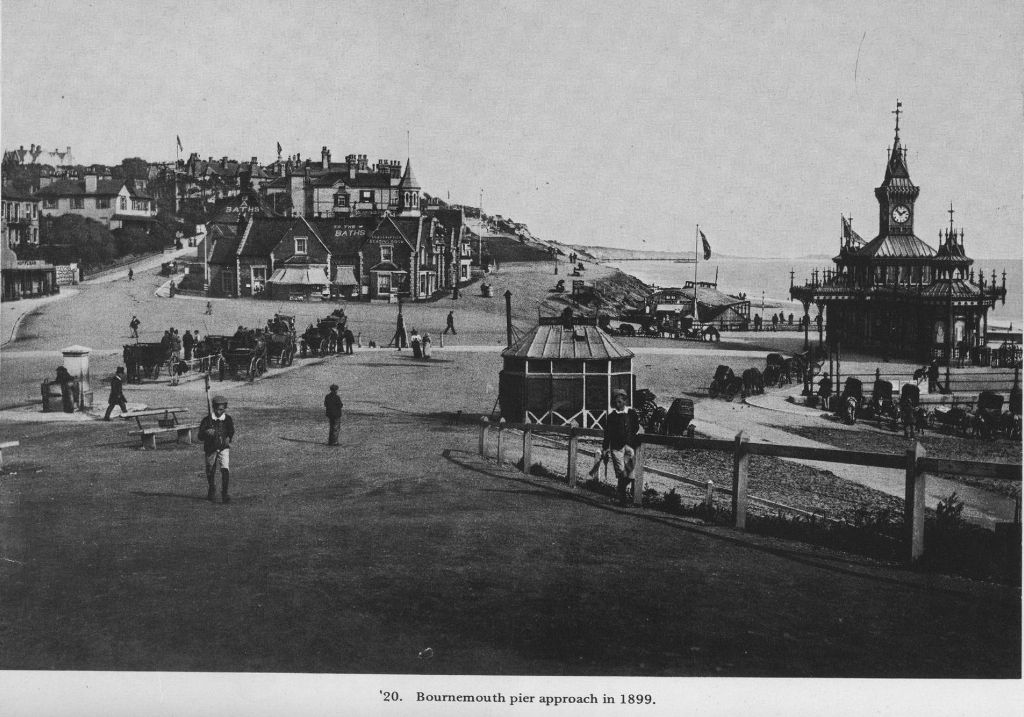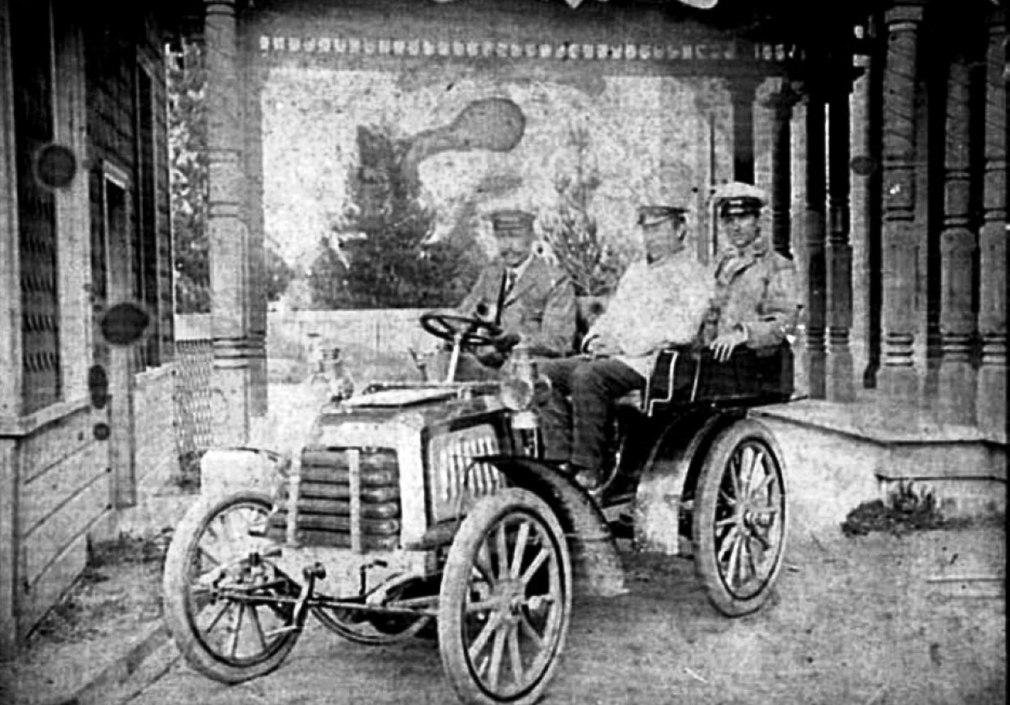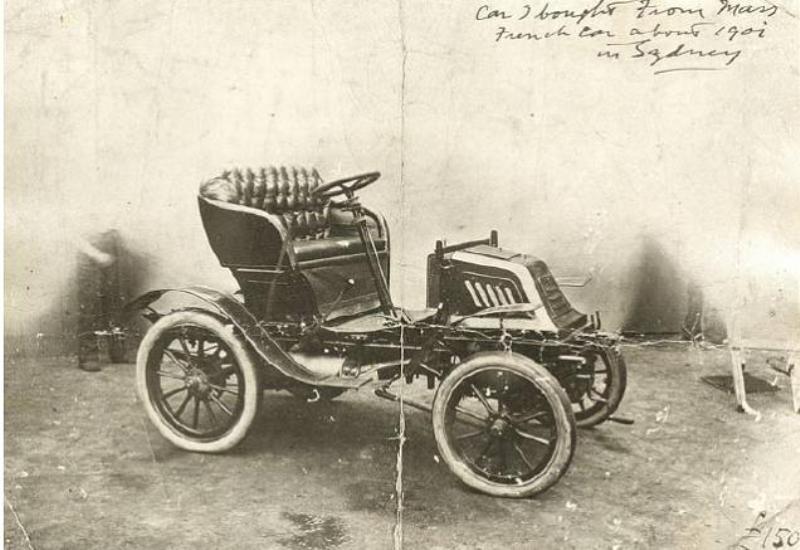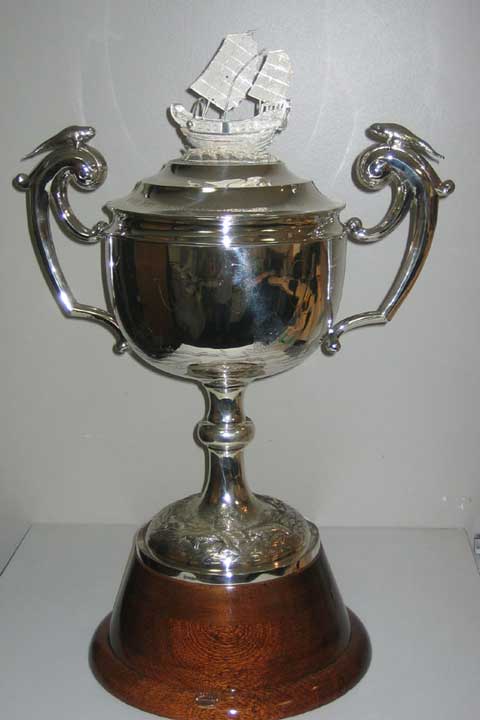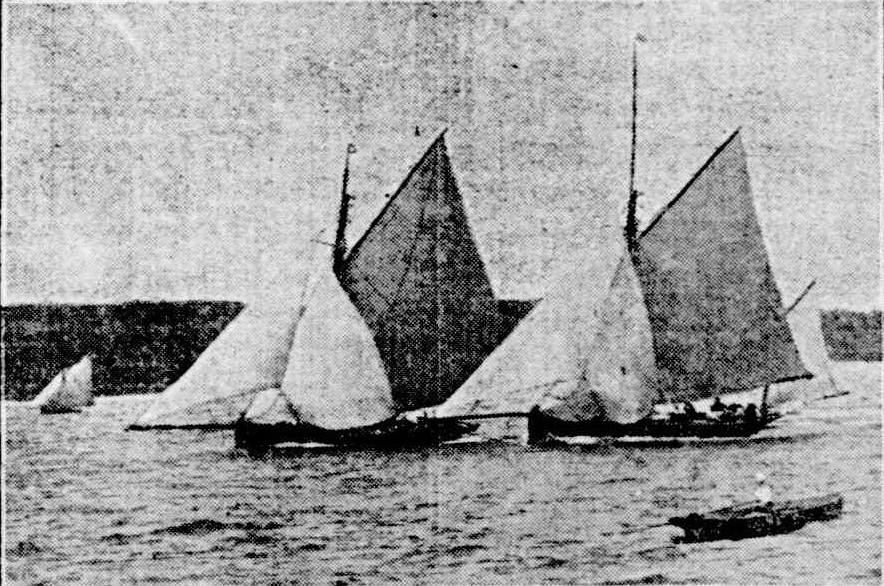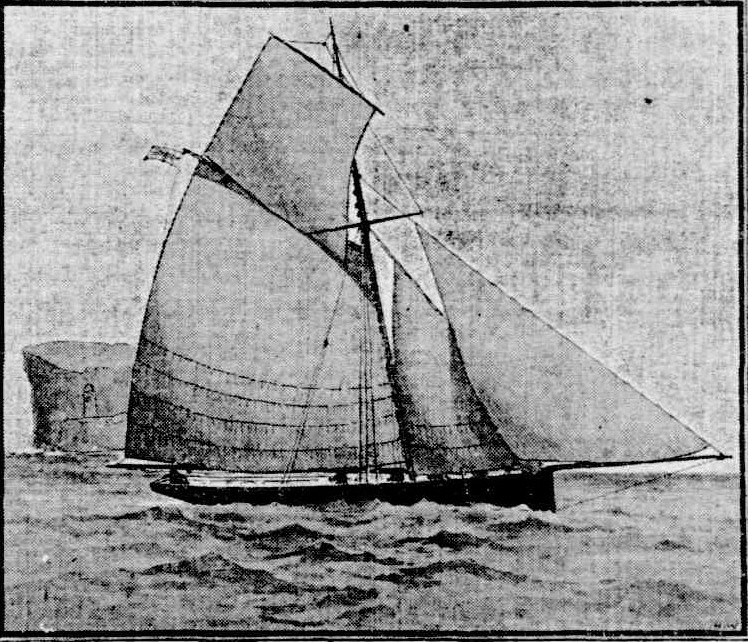Mark Foy
15 February 1865 - 15 November 1950
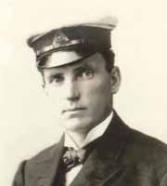 In the life of Mark Foy is seen some of our pioneer Australian spirit, our impetus to get up and go, to create new frontiers where old class systems tried to place obstacles by establishing sailing for all, especially the working man, and being the founder of the Sydney Flying Squadron in 1890 (some sources state it was 1891, others cite 1892) as well as introducing handicap racing, which was originally referred to as the 'Mark Foy System';
In the life of Mark Foy is seen some of our pioneer Australian spirit, our impetus to get up and go, to create new frontiers where old class systems tried to place obstacles by establishing sailing for all, especially the working man, and being the founder of the Sydney Flying Squadron in 1890 (some sources state it was 1891, others cite 1892) as well as introducing handicap racing, which was originally referred to as the 'Mark Foy System';
The Columnist Neptune encouraged the club to support the new Mark Foy system. Named for the Australian who invented it, this system of staggered start times according to handicaps, so that participants and spectators know exactly where the boats place without having to wait for the handicappers' report; Notes by "Neptune.". (1890, March 1). Australian Town and Country Journal (NSW : 1870 - 1907), p. 38. Retrieved from http://nla.gov.au/nla.news-article71108468
His contribution to sailing has resulted in his being inducted into Australian Sailing's Hall of Fame in October 2019.
Mr. Foy exemplified how business can be combined with pleasure and sportsmanship, whichever area or state of Australia you may be in, as the list of Mark Foy Cups or championships run in sailing and horse racing extended from Queensland to Western Australia and follows a pattern of introduction that aligns his setting up and opening of further Mark Foy stores in these same areas. Mark Foy is also among the first people on record to ensure Pittwater’s beautiful spotted gums stayed where they belong;
SPOTTED GUMS AT BAYVIEW.
Bayview, one of the most delightful of the many beauty spots round the waterfront at Pittwater, is more beautiful than usual today because of the presence of numbers of the young and middle-aged spotted gums on the roadside. Anyone, who has an eye for a tree trunk and a shapely headpiece, should see these hardwoods at work on their home holdings, over which Mr. Mark Foy and his neighbours hold sway. The grown trees are 30 and 40 feet in the barrel, and are quite perpendicular. All the young stock are lighter in body and shorter as well, but even the babies among these yellow-stemmed trees are as straight as a plumb line. Young trunks and old trunks, too, are coloured with unbroken bark of yellow-green pastel shade, blotched with spots of dull mauve, which clearly indicate the family to which they all belong. Only lately they were engaged in dropping their old bark in readiness for the work which has to be done during the year.
Thanks to Mr. Foy, Mr. Graham, Mr. Sinclair, and to the other tree lovers of Bayview, who are bent on preserving these native timber trees, visitors are able to enjoy from the roadside pictures which are too seldom seen on or near an outer suburban highway. In too many places all the native trees are cut down to make room for favourites from other continents. None of the Imported trees compare with those of our own wild land. Bayview's spotted gums stand head and shoulders above anything near them. While their present owners have power to protect them they are safe from the axemen. Recently, some splendid trees were taken off the roadside to make room for the electric light wires. Other trees were lopped or shortened for the same purpose. Many a bayside resident was sorry to see that work done. However, the chopping could not well have been avoided. The men who handled those spotted gums did their work feelingly, and saved every tree they could. SPOTTED GUMS AT BAYVIEW. (1930, January 3). The Sydney Morning Herald (NSW : 1842 - 1954), p. 10. Retrieved from http://nla.gov.au/nla.news-article16615090
Mark Foy had a residence in Pittwater called 'The Cabin' at 28 Bay View Road before this access was renamed 'Pittwater Road' by Warringah Council. Other family members also purchased property in Pittwater. His youngest sister Sophie, through her marriage to James Joseph Smith, had also been a visitor to Pittwater and the family had a property called 'Trincomalee' at Elvina Bay, while sister Alice married James Joseph Macken, a family still well known here, who have been associated with Collaroy and Coasters for many decades.
IN consequence of leaving for Algiers, Mr. Mark Foy's residence, EUMEMMERING HALL, Bellevue Hill, is to Let on lease for a term of 5 years: also a water-frontage seaside Residence, THE CABIN, Bayview, Pittwater, 6 rooms, motor garage, and boathouse and baths. SHELEAGH COTTAGE, Medlow Bath, tho mosthandsome cottage on the Blue Mountains, electriclight and water laid on, beautifully furnished', also GLENARA COTTAGE, Medlow Bath, unfurnished, anda dwelling-house at Blackheath, six rooms, unfurnished. THE BUNGALOW, In KANIMBLA VALLEY, also STOEWER OFFICE, 12 City road. Full particulars of all these propcrties at HOOAN'S KIOSK, VICTORIA ARCADE.Opposite the Australia Hotel. Advertising. (1914, April 11). The Sydney Morning Herald (NSW : 1842 - 1954), p. 25. Retrieved from http://nla.gov.au/nla.news-article15500675
This 'early departure to Europe', and a leasing of his properties at that time due to this, gives an insight into this list:
MR MARK FOYS PROPERTIES
The following places are to Let on Lease -
EUMEMMERING HALL BELLEVUE HILL,
THE CABIN BAYVIEW, PITTWATER.
Large Water frontage Dwelling; at NEWPORT
LARGE SHOP, 12 City road near Grace Bros
SHEILAH COTTAGE, MEDLOW BATH.
GLENARA COTTAGE, MEDLOW BATH
LARGE STABLES, MEDLOW BATH
THE VALLEY FARM, MEDLOW BATH.
DWELLING HOUSE near station BLACKHEATH.
BUISINESS PREMISES, near Elizabeth street – suitable for a Dentist
Medlow Bath stables, New South Wales, courtesy National Library of Australia, image no.: nla.obj-146216810-1, [ca. 1910]
Mark Foy, circa 1910
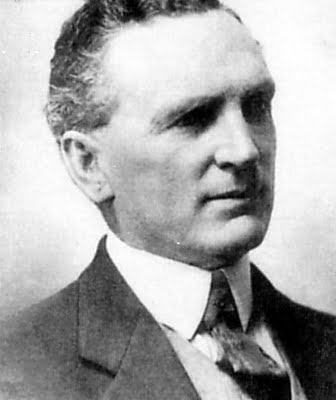
Mark Foy continued to travel every year. World events which affected the high seas on one occasion meeting his path mid-voyage on the aforementioned trip:;
MR. MARK FOY A PRISONER. A letter received in Sydney from a German resident at Yap Island, near Carolines, stated Mr. Mark Foy, of Mark Foy Ltd. was a prisoner there MR. MARK FOY A PRISONER. (
1914, October 9).
Bendigo Advertiser (Vic. : 1855 - 1918), p. 8. Retrieved from
http://nla.gov.au/nla.news-article90727010 and;
MR. MARK FOY. PRISONER OF WAR Mr. Mark Foy, who recently left Sydney on a pleasure trip to Japan, has had a novel and exciting experience. He left Sydney in a German mail steamer, and while the vessel was on the Australian coast war was declared between England and Germany. The vessel immediately altered her course, and the passengers, much to their surprise, were landed at Rabaul, in New Britain, where they had to shift for themselves as best they could. Mr. Foy remained on the Island some days, and, finding it impossible to get away by other means, chartered a small vessel with the assistance of other passengers in which they proposed to make for the Philippine Islands. Their troubles were not at an end, however, for their new craft struck a reef, and was wrecked. The passengers and crew were picked up by a passing vessel and conveyed to Yap. Mr. Foy cabled to Sydney from Yap, stating that he was well. A letter however, was received in Sydney a couple of days ago from a German source stating that Mr. Foy was detained as a prisoner of war, together with the British Consul, and the pair of them had been placed on a small island near Yap. It is likely, however, that Mr. Foy has since been released, for the Japanese have taken possession of Yap, and that he will be able to continue his voyage to the East or return to Sydney. MR. MARK FOY. (1914, October 10). The Sydney Morning Herald (NSW : 1842 - 1954), p. 12. Retrieved from http://nla.gov.au/nla.news-article15537531
Mr Foy brought cars and car racing to Australia, was a proponent of motor boats and cruisers, and these were just a few of the investments he made in Australia. The list of health initiatives he contributed large sums to reflects early tragedy in his own life as much as a few personal health scares and an unceasing love of world wide travel paralleled bringing the latest and best back to Australia when people journeyed by ship.
A few motor launch insights:
AN AQUATIC FUNERAL.
(For letterpress see "Yachting.")
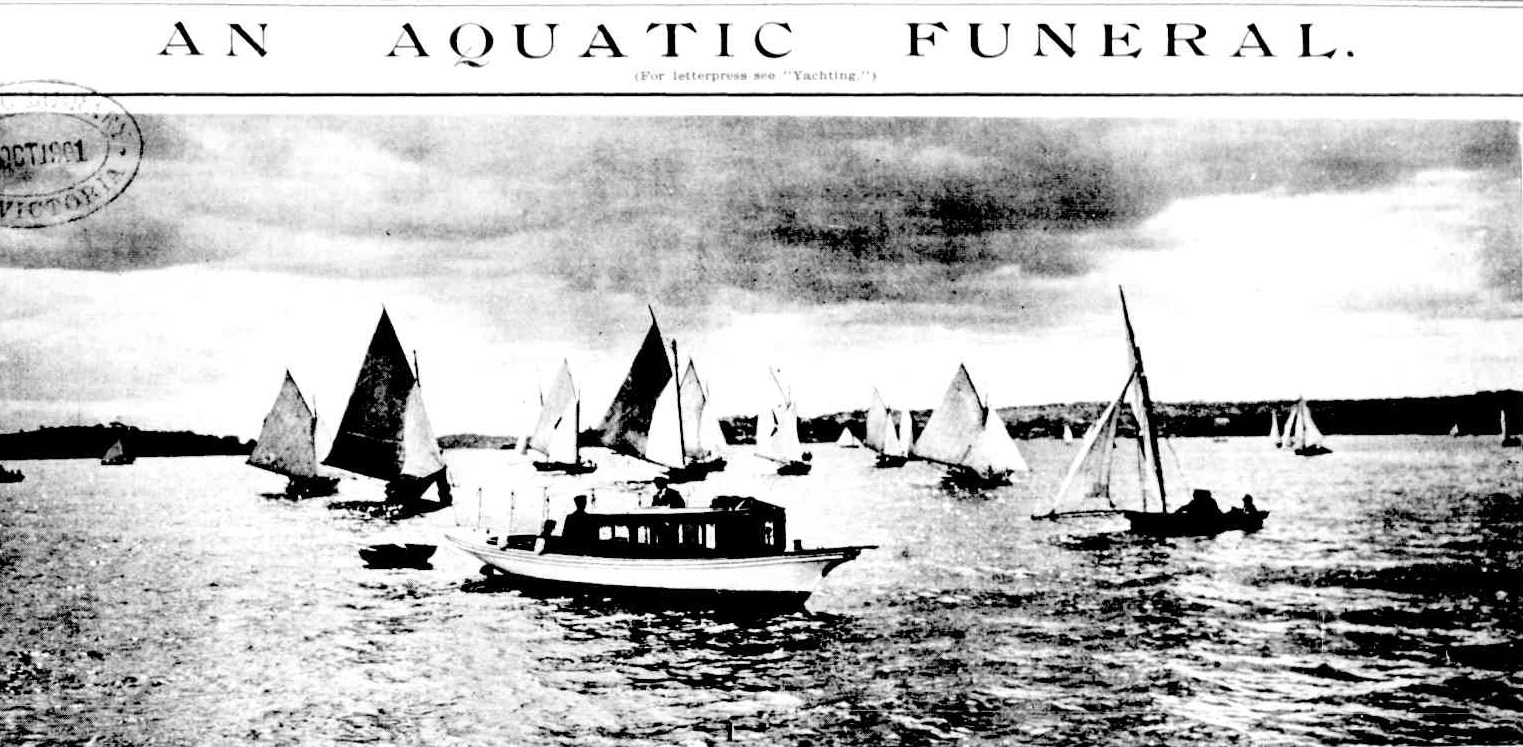
Mr. Mark Foy's Launch Leading the Fleet. 2.-The Steamer Carrying the Coffin, Clark Island. 3,-Landing at Watson's Bay. 4.-The Procession of Sailing Boats Down the Harbor.
The members of the Sydney Flying Squadron have every reason to be pleased with the success which attended their efforts on Sunday afternoon, to mark, by means of an aquatic funeral, the esteem in which.they held an old comrade, Mr. A. E. G. Thomas, who died at Samarai, New Guinea, twelve months ago. The remains were brought to Sydney for interment, and the members of the squadron, of which Mr. Thomas had been secretary for a number of years (some articles on this funeral state he helped Mark Foy found the club), were determined to mark their appreciation of the great assistance he had been in bringing it to its present successful position, by according his remains a unique and at the -same time a distinctly appropriate funeral. The aquatic ceremony of Sunday afternoon was the first of its kind that has ever taken place on the. waters of Port Jackson. Those who witnessed it, whether from steamers, sailing boats, or the shore, must have been strongly impressed with the picturesqueness of the solemn procession.
The steamer Agenoria with the coffin and. relatives of; the deceased left Circular Quay about 2 o'clock, proceeding to Clark Island, in the vicinity of which the various craft taking part had been notified to assemble in order to take up the positions allotted to them in the procession. The owners and crews made a liberal response to the call for their attendance, for between 80 and 100 sailing-boats of all classes took part in the funeral, each bearing the Sydney Flying Squadron colors carried halfway up the after leach of the mainsail. ' The steamer Garnet left the Quay shortly after the Agenoria, having on board a full complement of members and friends of the squadron. Mr. Mark Foy, commodore of the S.F. Squadron, attended in his launch Marionette.
A number of sailing boats other than those belonging to the squadron took part, also.a number of launches, including those belonging to Mr. H. C. Pritchard, on which members of the press and photographers were accommodated by Mr. W. Holmes. The cortege left Clark Island about a quarter to 3, the steamer Agenoria leading the way, the sailing boats following in her wake. The procession passed Shark Island on the southern side, and went in stays, and stood over to Taylor Bay Point, where they came about again, and then lay a course for "Watson's Bay, the wharf being reached shortly after 4 o'clock. ... An Aquatic Funeral. (1901, October 19). Australian Town and Country Journal (Sydney, NSW : 1870 - 1907), p. 23. Retrieved from http://nla.gov.au/nla.news-article71473386
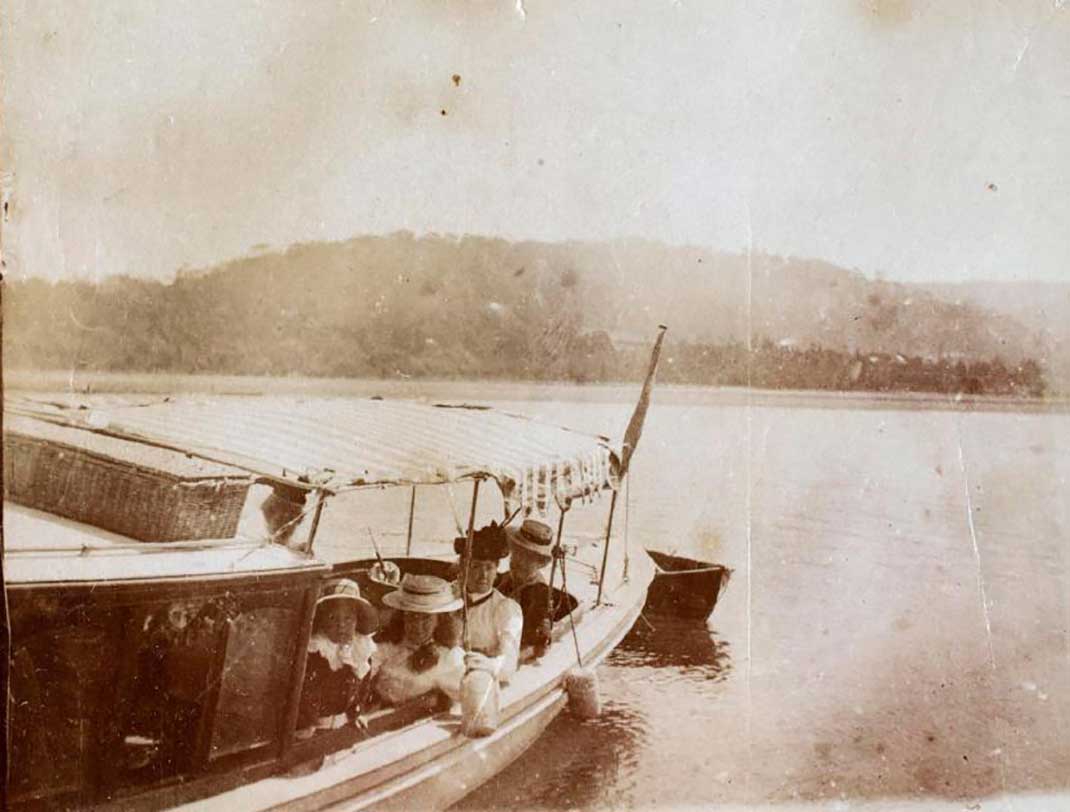
Marionette, circa 1901, from ANMM Collection, gift of Mary Shaw

Internal combustion driven launch Marionette being loaded, circa 1901, from ANMM Collection, gift of Mary Shaw
MOTORING 'ON THE WATER.'
The latest information received in Adelaide from England states that the King who has always taken a keen interest in motoring on land, has recently entered with enthusiasm on the new development of the motor, which is seen now on the waters along the English coasts. There does not seem to be any valid reason why South Australians should not enter heartily into the same sport, for there is ample sea space to practise on round the shore from Brighton to Largs Bay, while it is a very simple matter to run the motors into safe harbor when rough weather threatens. In European waters the oil launch-a dainty looking boat, containing an engine similar to that of the best French motor cars, capable of speeds running from ten miles up to 30 miles an hour-has long been popular, while of late years its vogue has almost rivalled that of the motor cars.
In Sydney the European fashion has already been largely followed, and the Daily Telegraph states that there are today 300 oil launches on "the beautiful harbor." Mr. Mark Foy, a great patron of automobilism, was among the pioneers of the sport there. TOPICS OF THE DAY. (1904, September 21). The Advertiser(Adelaide, SA : 1889 - 1931), p. 4. Retrieved from http://nla.gov.au/nla.news-article5007959
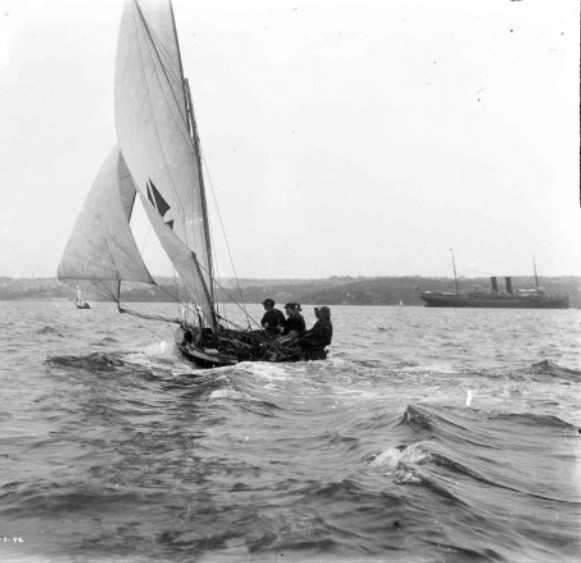 The note that resonates strongest from masses of material is a love of sailing and his favourite vessel, the Flying Fish, an earlier catamaran which he tried to find or rebuild once she disappeared.
The note that resonates strongest from masses of material is a love of sailing and his favourite vessel, the Flying Fish, an earlier catamaran which he tried to find or rebuild once she disappeared.
The picture at left, courtesy of the Australian National Maritime Museum and dated 1898, is one version of this favourite.
An article regarding her modifications from a gentleman known only as 'Clipper', who claims to have witnessed a SFS meeting, may be found in the Australian Historical Sailing Skiff Association Inc. August Newsletter 2012 HERE
Sailing Man's Search For Freak Racer
The old racing 24-footer Flying Fish is being anxiously sought by the well-known sailing enthusiast Mr. Mark Foy.
If the hull can be found, even in a derelict condition, Mr. Foy plans to build a big racer, 60ft long, on the same lines. For some time he has been advertising a reward of £5 for news of the boat's whereabouts. Several reports that she was at George's River, and had become a houseboat, have proved untrue. The whereabouts of Flying Fish is still a mystery.
Sailing veteran and boatbuilder Peter Cowie believes the lost boat will never be found. Some years ago the late Jack Gorman told him Flying Fish broke from her moorings at Pittwater and drifted out to sea. Mr. Foy, who gave Gorman the freak racer nearly 50 years ago, said last night that this explanation was quite plausible.
He claims that Flying Fish had an amazing turn of speed on a beam wind. She often sailed past Manly ferries, and out-distanced all-comers on the harbour. Shortened by two feet to enter an ocean race Flying Fish won it by about three miles, according to Mr.Foy. The craft was of unorthodox build. She was actually two boats, each of 2ft 3in beam, bolted together by two cross pieces, one at the mast and one further aft. Flying Fish carried a crew of 20. She was rigged with a French lug sail and overall measured 60ft from bowsprit to tip of bumpkin. Mr. Foy is confident that if the Flying Fish could be found and reproduced with a 60ft hull the new boat would be a record-breaker.
''She was perfectly balanced," he declares.
A copy named the Flying Fox did not have the same balance and proved a complete failure. Mr. Foy is dubious about the success of any other attempts to duplicate the performance of the craft without her exact dimensions. Sailing Man's Search For Freak Racer. (1946, February 26).The Sydney Morning Herald (NSW : 1842 - 1954), p. 8. Retrieved from http://nla.gov.au/nla.news-article27919832
Mark Foy with family and friends on catamaran Flying Fish, 1890s - ANMM Collection, gift from Mary Shaw.
Mark Foy's Flying Fish, from ANMM collection, gift from Mary Shaw
Mark Foy was born at Bendigo on February 15th 1865 to Mark Foy and Mary (nee Macken). His father, a draper in his former home of Dublin, had moved to Melbourne by 1870 and set up a store in Smith Street, Collingwood that prospered and had become big enough to occupy six shops by 1880. He was already a keen sportsman winning medals in the United States of America for rifle shooting.
At the age of 19, in 1884, he moved to Sydney with older brothers Francis and Hugh Victor, with sisters Alice and Sophie included, to set up their own store. The stories of how this came about are many. One of them;
Fateful Toss By A. L. BRIENT . IN HIS ARTICLE on the origin of some of Melbourne's famous old stores (Week-end Magazine, 2/4/49), Ron Testro mentions the circumstances in which the Foy and Gibson partnership was dissolved. As two of Australia's leaders in the retail drapery trade were concerned, the story seems worth telling in greater detail. William Gibson; by the way, was a comparative latecomer into the business, which had been established by Mark Foy in the Victorian gold-digging days, first at Bendigo, afterwards extending to Greytown and Castlemaine (in partnership with a Mr Bentley), and finally to Smith st, Collingwood (1868). It was in Collingwood that Mark Foy's elder son, Francis, grew to manhood, and during his father's declining years (he died in 1882 while on a health trip in USA), became responsible for the conduct of the business.
It was in this period that William Gibson, a Scottish commercial traveller, with capital to invest on behalf of his uncle, Robert Dick, well-known Glasgow leather belt manufacturer, became a partner. Then something entirely unpredictable happened. While Francis Foy was absent on a prolonged buying mission, William Gibson, fascinated by the overhead cash-carrier system then coming into favour, installed one in the Smith st premises as a surprise for his partner on his return. However, it was with a wry sort of smile that Francis Foy beheld the new contraption. It was not because he was opposed to innovations. On the contrary, his reputation was that of a man ever on the look-out for new ideas in business. It was that he had not been consulted on a major item of expenditure.
THEN HE DECIDED that Smith st could not hold both Gibson and himself. So it was that each partner agreed to write down his valuation of the share he held in the business, and decide who should buy the other out on the toss of a coin. Francis Foy never baulked at risks. He won the toss. Gibson's disappointment was manifest in his face, although he was prepared to stand by the bargain. Francis Foy, son of an emotional Irish mother and a mercurial French father, relented. "Consider you've won," he exclaimed. "I will take your chance, sell at the figure I've given (£8,000), and go to Sydney." Conservative estimates at the time were that the amount should have been more like £60,000. Nevertheless, Francis Foy left Smith st, never to return (although a regular visitor to the Melbourne Cup meeting),opened in Oxford st, Sydney, under his father's original sign, "Mark Foy," and in 20 years made £1 million. Today, the business is carried on in palatial premises in Liver-pool st. Francis Foy died in 1918, in the Sydney express, returning from the Melbourne Cup of that year. William Gibson did not forsake his old partner during the difficult period of finding a footing in Sydney. He was always ready to lend an expert or two from his Smith st staff, to tide over a difficulty in the new city. I have mentioned Francis Foy's French ancestry. His paternal grandfather, a stubborn monarchist, fled from Paris during the French Revolution, and acquired a flour milling business and a fortune in Ireland, but lost all when his bank failed. Fateful Toss. (1949, June 18). The Argus (Melbourne, Vic. : 1848 - 1956), p. 5 Supplement: The Argus Week-End Magazine. Retrieved from http://nla.gov.au/nla.news-article22735875
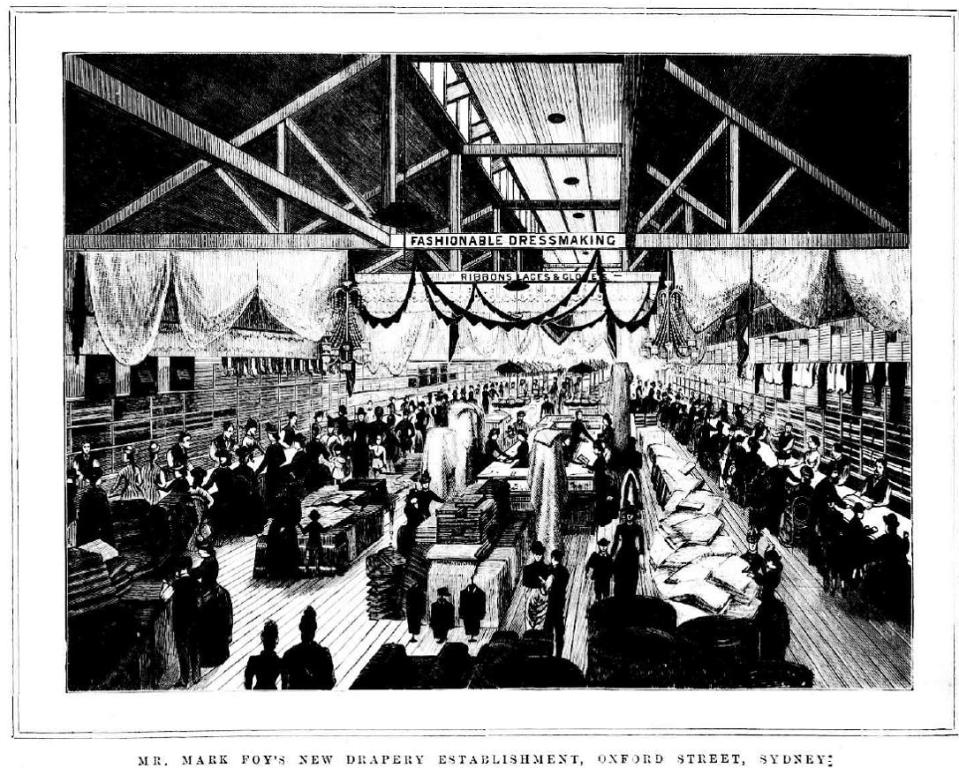
MR. MARK FOY'S NEW DRAPERY ESTABLISHMENT, OXFORD STREET, SYDNEY. (1885, October 24). Illustrated Sydney News (NSW : 1853 - 1872), p. 16. Retrieved from http://nla.gov.au/nla.news-article64036628 and Mr. Mark Foy's Drapery Establishment,
MOST old Victorians, or even those who have made only occasional visits to Melbourne, will remember the establishment of Mr. Mark Foy, in Collingwood. This enterprising gentleman made it amongst the most famous places of business in the southern city or its suburbs, and its proprietor was as widely known as he was generally respected. The firm have now opened an establishment of a similar kind in Oxford Street, Sydney. The new premises have just been completed, and business is now in full swing. Our illustration gives a capital and graphic idea of the interior of this extensive and handsomely fitted establishment, which, during the afternoons and hours when ladies usually indulge in the amiable weakness of shopping, is a. perfect beehive of life and activity. We have no doubt the enterprising proprietors will reap the full reward of their energy, capital, and farsightedness in their new venture. , Mr. Mark Foy's Drapery Establishment. (1885, October 24).Illustrated Sydney News (NSW : 1853 - 1872), p. 13. Retrieved from http://nla.gov.au/nla.news-article64036651
Mark Foy senior, after whom this store was named, to honour him, actually died in 1884:
FOY.—On the 14th ult., at San Francisco, of Bright's disease, Mark Foy, J.P., eldest surviving son of the late Mark Foy, Esq., Moystown Mills, King's County, Ireland. Requiescat in pace. Family Notices (1884, February 23). The Australasian (Melbourne, Vic. : 1864 - 1946), p. 10 (AUSTRALASIAN SUPPLEMENT). Retrieved from http://nla.gov.au/nla.news-article138650245 FOY –In loving remembrance of Mark Foy, JP, Collingwood, who died of Brights disease and gangrene of the leg at San Francisco, on the 14th of January, 1831, aged 54 years. Family Notices. (
1885, January 14).
The Argus (Melbourne, Vic. : 1848 - 1956), p. 1. Retrieved from
http://nla.gov.au/nla.news-article6065050
FOY.—In loving remembrance of Mark Foy, J.P., Collingwood, who died of Bright's disease, on the 14th January, 1884, at San Francisco, aged 54. Family Notices. (1886, January 14). The Argus (Melbourne, Vic. : 1848 - 1956), p. 1. Retrieved from http://nla.gov.au/nla.news-article6080307
These notices would have been placed by Mark Foy senior's second wife Catherine (nee Power);
In the Equity Court on Wednesday last, before His Honor Mr. Justice Molesworth, an action of the Trustees, Executors, and Agency Company, Limited, v. Foy, was heard. The plaintiffs were executors of the will of the late Mr. Mark Foy, draper, of Smith-street, Collingwood, and the defendants, Mrs. Catherine Foy, widow of the testator, and Maximilian John Foy, his infant son, now aged three years, who was represented by Mr. David Power (name of both father and brother of Catherine)as guardian ad litem. The deceased died on the 14th of January, 1884, at San Francisco, California, leaving a will executed at the same place on the 13th December, 1883. Mrs. Catherine Foy was the second wife of the testator, and the infant defendant is his only child by her. The present action was brought to have the will of the testator construed by the court.
Mr. Foy (Snr.) by his will bequeathed sums of £5 to his daughter, Mary Anne Foy, and £500 to his sister, Miss H. F. Foy, of Bourke-street, Melbourne. He then directed that the residue of his estate should be held in trust by the widow for her child and herself, share and share alike, but provided that in the event of the widow marrying again, the whole of the residue should go to the child. He explained that he did not make any provision by his will for his children, Francis Foy, Mark Foy, Hugh Victor Foy, Alice Foy, and Sophie Foy, because he had already provided for them otherwise. The deceased appointed the plaintiffs and his widow executors and executrix of his will, but the latter renounced, and probate was granted to the company alone. The deceased left real property of the value of.£1696, and personal property of the value of £14,400. His debts amounted to £881.The immediate object of the present action was to ascertain from the Court what was to be done with the corpus of the widow's half of the residue. It was pointed out on behalf of the plaintiffs that if she got possession of it she might spend it and then marry again, when the money could not be recovered from her. On behalf of the widow it was submitted that she was entitled to the possession and absolute control of one-half share of the corpus, and that as to that share no trustee should be appointed. The moiety claimed by Mrs. Foy amounts to about £7607. Mr. Higgins, instructed by Messrs. Davies and Campbell, appeared for the plaintiffs; Dr. M'Inerney, instructed by Mr. Walter Davies, for the defendant, Mrs. Foy; and Mr. Campbell, instructed by Mr. C. S. Price, for the infant defendant. His Honor reserved judgment. LOCAL BUILDING SOCIETY, BRUNSWICK. (
1884, October 25).
Mercury and Weekly Courier (Vic. : 1878 - 1903), p. 2. Retrieved from
http://nla.gov.au/nla.news-article59752597
From the beginning the store was a moneymaker. Indeed on the opening day police had to be called to disperse the crowds in Oxford Street waiting to enter. Trouble was they were holding up the steam trams. The success of Mark Foy's was mainly due to Francis Foy's business ability and his flair for the unusual.
Instead of periodical sales like other stores he advertised all over Sydney: "Foy's fair is now on." He also invented the slogan: "Aim straight fore Mark Foy's." When balloon ascents were making headlines in Sydney making headlines in Sydney Francis Foy hired one of the balloonists to take off from Hyde Park near his shop. But the balloon got away and wrapped itself round a tower on top of his competitor. Anthony Hordern's in the Haymarket. Old Samuel Hordern was furious, especially when he saw the slogan on the baloon's side: "Aim straight for Mark Foy's."
Mark Foy's developed into a department store and early in the 1900s it was obvious new and bigger premises were essential. Francis Foy had his eye on the island block bounded by Elizabeth , Liverpool, Castlereagh and Goulburn Streets, then a ramshackle warren of small shops, cheap cafes, Chinese herbalists and animal dealers.
There were 15 separate pieces of land in the block and Foy had 15 different people quietly buying them up on his behalf so he got the whole block at a remarkably cheap price ranging from $24 to $40 a foot. Once he had the land Foy took an architect overseas with him to inspect the world's great department stores. Eventually they decided to built on similar lines to the famous Bon Marche in Paris. The result was Mark Foy's store known as the Piazza and opened in September 1909. Mark Foy retired from active participation in the business then. He had wound back his work there earlier while investigating and pursuing other interests.
A description of the new store:
BUILDINGS AND WORKS. PROGRESS OF THE TRADE. MARK FOY'S NEW BUILDING.
The work of erecting new premises for Messrs. Mark Foy has been commenced by the contractors, Messrs. Douzan Brothers, and when completed the building will prove a valuable addition to the work of remodel-ling the southern end of the city. The site is at the corner of Liverpool and Elizabeth streets, and runs right through to Castlereagh-street, and almost to Goulburn-street, so that the building will stand on more than an acre of ground, and the floor space provided in the plans will total upwards of three acres. The building will have elevations to three thoroughfares. Owing to the steep grade in Liverpool-street, the architects, Messrs. M'Credie and Anderson, have designed in such a manner that there will be three stories in the Castlereagh-Street frontage, and only two on the Elizabeth-street side. At the northern end there will be a piazza 21ft wide, and level with the Elizabeth-street corner, and approached from Liverpool-street by a magnificent flight of steps ex-tending the whole of the Liverpool-street frontage. The piazza will be covered by a suspended glass awning, containing an ornamental centre feature, something new to Sydney. The main entrance to the building will be at this end, and will lead directly into the manchester and dress department. The main staircase is provided for in a centre block of the building, octagon in shape, and 73ft each way in dimensions. This broad staircase starts from the centres, and emerges into a half landing, and from there a wide flight of steps leads to the first floor, where the lace, ribbons, and other departments have been placed. A wide and ornamental entrance on the Elizabeth-street frontage leads to the centre or staircase block, on the main floor. On the Castlereagh-street side there is also an extensive entrance, by which an elevator is reached that will convey customers to the main floor, and there a revolving staircase is to be built leading to the first floor. This staircase will be quite a novelty to Sydney people. It is to be so constructed that a person placing his feet upon the bottom step-is quickly raised to the upper floor of the building without any exertion on his part. The whole of the departments on the immense floor space are to be so arranged as to be grouped into sections, and conveniently situated to each other, in order to simplify the arrangements, and give to the customers a maximum amount of comfort for a minimum amount of exertion. At the southern end, on the first floor, will be two spacious dining-rooms, one for the public, and one for the employees. The central features on the Elizabeth and Castlereagh streets sides will be carried up an extra story, and this will provide for ladies' re-tiring rooms. This central feature, octagon in shape, will be lighted by means of a dome constructed of large sheets of glass in steel framing. The whole of the internal fittings, including counters,' showcases, etc., will be made from Siberian oak, especially selected by Mr. Anderson during his recent tour abroad. The ceilings throughout will be in stamped metal. But the great feature of the building will be the magnificent show windows running right round the three frontages. Those on the Elizabeth and Liverpool streets sides will be constructed on the V principle. To the Elizabeth-street frontago there will be two rows of these windows. 124ft long each, and unbroken by a single column or pier; and only divided by the Ellzabcth-street en-trance. The show windows on the western side will be level with Castlereagh-street. They will be straight, and in bays of 23ft each, so that the whole will produce a lengthy and magnificent display of glass for show purposes. The street awnings on the Elizabeth and Castlereagh Streets frontages will be ornamented with an emdeca tile ceiling.
Mark Foy’s Building, Sydney], c1909. Studio line reads “Kimbel & Co. Alex Weir Manager. 76a Pitt St, Sydney.” Inscription reads “Adrian Douzans, builder & contractor for Mark Foy’s Ltd building, 1908-1909.” Originally part of the Josef Le Bovic gallery of historic items.
The building will be constructed throughout of steel, while the exterior walling around the steel framing will be in white glazed bricks, with bands and other ornamental work of yellow faience, which is an English clay burnt and glazed. The elevations will be attractive, and the general design, as well as being extensive, will be most pleasing. The roof will ho covered with purple Bangor slates and there will be a tower on each corner, with the central feature and dome already described surmounting the whole. The general arrangements will be similar to those In the latest Paris houses, particularly the Bon Marche. A very large proportion of the material to be used in the work Is now being Imported. The contractors for erecting the building are Messrs. Douzan Brothers; the ceiling work will be entrusted to Messrs. Wunderlich, Limited. The lead and glass for the faience work will be supplied by Messrs. Burmantofts, Limited, of Leeds, England. The mosaic Venetian glass signs In the panels of the frieze under the first floor windows something entirely new to Sydney - will be provided by the firm of Diespeker Limited, of England and the Continent.. The Shawarlgg Brick Company of Glasgow will supply the glazed bricks, with which the whole of the outer walls are to be built. The steel for constructional work, of which there will be a good many tons, will come from the Ascerics Steel Works, In Belgium. The suspended awning will be made by Messrs. Swartz and Muerer of Paris; while the revolving staircase will be supplied by Messrs. A. Plat and Son, also of Paris. It is estimated that the whole work will run into something between £70,000 and £80,000. BUILDINGS AND WORKS. (1908, January 7). The Sydney Morning Herald (NSW : 1842 - 1954), p. 4. Retrieved from http://nla.gov.au/nla.news-article14871344
This item, from the time when the 'Great White Fleet' of America was visiting Australia, and Sydney, arriving in our harbour of August 20th, 1908, mentions the as yet to be opened 'Piazza'
MARK FOY'S FAIR.
At this period it is considered proper for the majority of folk to be concerned in naval affairs, hence the many windows of Mark Foy's establishment have a nautical flavor. They are illustrated with a series of well-painted battleships, ancient and modern. One window has a picture of the future airship, with its guns ready to play havoc with the city below. The windows daily draw a large crowd of sightseers, and many enter the establishment to see the wonders of the Fair. It is a Fair, for it seems safe to assume, every possible, article in connection with drapery and furniture is to be obtained, and in a large measure the people act as buyers and also sellers, the goods are displayed on the many counters, and the people make their own selection.
This is the last Winter Fair that will be held at this old and favorite house. Within twelve months Mark Foy will be established in his new palatial premises in Elizabeth-street, near Liverpool street. For the benefit of the large section who are compelled to shop by post, a small but useful booklet, entitled, 'Fleet of Good Values' has been .compiled. A copy may be obtained by writing. MARK FOY'S FAIR. (1908, July 14). Evening News (Sydney, NSW : 1869 - 1931), p. 6. Retrieved from http://nla.gov.au/nla.news-article114756974
AN EMPORIUM OF COMMERCE. MARK FOY'S NEW BUILDING.
Mark -Foy's fine new block, at the Intersection of Liverpool, Elizabeth, and Castlereagh streets, has been open to the public for some days past, and no doubt thousands of people know all about It. On the other hand, there are still thousands who know It not, and for these many surprises are in store.
Yesterday an Inspection of tho building showed that there was any amount of work, such as finishing touches to decorations, show bases, &c., to be done, but there was abundant evidence that the new emporium of the old popular Oxford-street firm will be one of the sights of. Sydney. -The front is approached by a broad piazza level with the Elizabeth-street corner, and extending right across tho frontage. The main entrance, through handsome mahogany doors, leads Into the dress and manchester departments, which occupy the north-western portion of tho main floor. From this entrance an uninterrupted view of tho whole length of the building can be obtained. The effect, looking down a colonnade of handsomely-decorated columns, Is a most striking one. Close to the central entrance elevator Is one of tho novelties of tho building — the travelling staircase— upon which one may step, and, without any further exertion, be landed on the . upper floor. This staircase Is tho first of Its kind In Australasia, If not In the Southern Hemisphere. The upper floor has a public dining-room at tho southern end, with very line painted glass screens round the well-hole into the show-room, a dining-room for employees, the book department, a ladles' reading and writing-room, chemist's department, post pillar, basketware and trunks department, telephone bureau, Iced drinks fountain, and the staircase to the ladles' lavatory, while tho passenger lift and staircase to the female employees' lavatory are on the Castlereagh-street side. The section of -this floor on the Castlereagh-street side and the Liverpool-street front is occupied by the Jewellery, bric-a-brac, nic-nacs, and ladies' boots departments. The lower floor Is devoted to furniture, carpets, linoleums. &c., on the Liverpool and Castlereagh streets sides: the grocery department being next to Elizabeth-street. Ironmongery and tho heavier goods will occupy tho remainder of the Castlereagh-street side, while on the opposite side, running along Elizabeth-street, will be the parcels, sorting, and packing rooms. The lower floor has been finished In white throughout, and consequently Is very well lighted without any recourse to artificial means. A very complete system of electric lighting has been Installed. In the adjoining building, separated from the main edifice, are the receiving and opening up rooms at the Castlereagh-street side, whence the goods will be distributed to the various departments, and at the Elizabeth-street end Is the despatch room, Into which tho travelling conveyor brings Its continuous stream of goods. The principal contractors for the building were Messrs. Douzons Bros. The electrical engineer was Mr. A. C. F. Webb. who superintended the entire Installation, which was most creditably carried out by Mr. Johnson The Messrs. Castles and Mr. I Clint were responsible for the whole of the wrought iron work, while the fitting up of the windows. counters, mirrors, and fixtures was carried out by Mr. East. For the decorative scheme Messrs. Crisp Bros., the well-knowft Sydney artists, were responsible. The Standard Waygood Company supplied and placed the lifts, and also arranged the running of the moving staircase. Strong suggestions were made to import a French engineer to ensure success, but a smart young Australian, Mr. Gordon Bennett, employed by the Standard Waygood Company, surmounted all difficulties, and brought tho machinery to a perfect balance and successful . running. Messrs. Steel and Poole, tho contractors, of Pyrmont, prepared a great quantity of steel work for the building, while the whole of the ceiling work. &c., was supplied by the well-known Wunderlich Co., of Sydney. AN EMPORIUM OF COMMERCE. (1909, September 15). The Star (Sydney, NSW : 1909 - 1910), p. 6. Retrieved from http://nla.gov.au/nla.news-article230494684
Mark Foy's was the first Sydney store to change from horse-drawn to motor delivery vans.
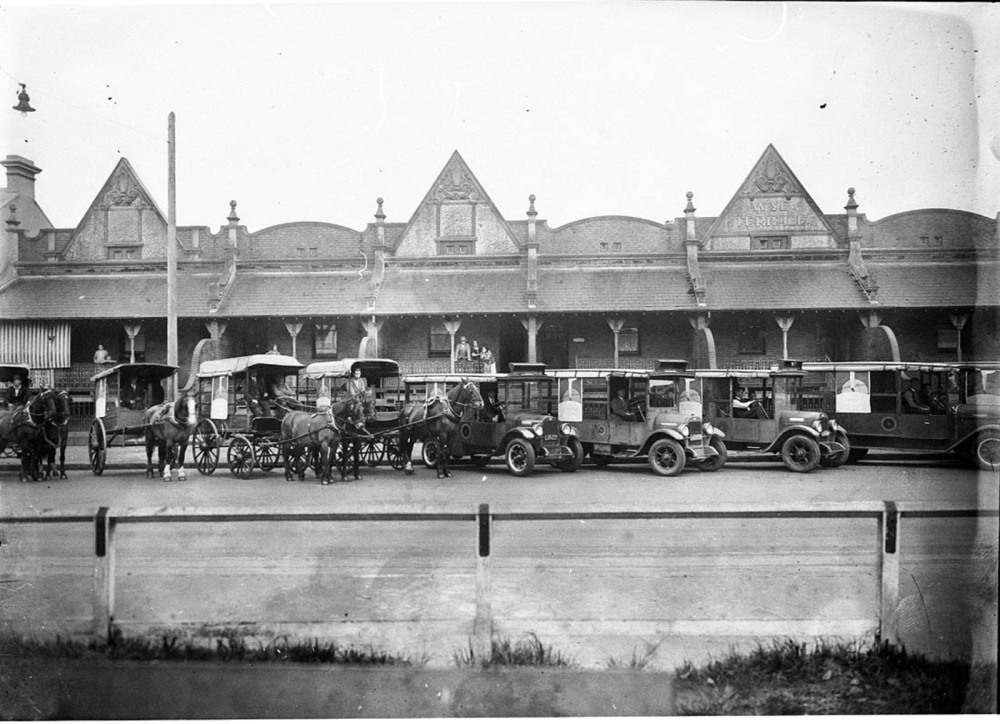
Mark Foy's Stables; Olivia Lane, Surry Hills c.1922 - from Home and Away Albums- 34921, Image.: hall_34921h, courtesy State Library of NSW
TRANSFORMATION OF MARK FOY'S
Mark Foy's Ltd., the well-known Piazza building, is to be transformed within, although the present style of architecture will be more or less followed throughout. When complete, the building will look like this. Messrs. Ross and Rowe are the architects. TRANSFORMATION OF MARK FOY'S (1926, May 28). Evening News (Sydney, NSW : 1869 - 1931), p. 5. Retrieved from http://nla.gov.au/nla.news-article117285171
PROPOSED NEW PREMISES FOR MARK FOY'S, LIMITED.
TO BE ERECTED ON THE SITE OF THE PRESENT BUILDING, BOUNDED BY CASTLEREAGH, LIVERPOOL, AND ELIZABETH STREETS.
THE TOTAL AREA OF THE NEW FLOORS WILL EXCEED 600.000 SQUARE FEET. THE ARCHITECTS. MESSRS, H. E. ROSS AND ROWE. HAVE DESIGNED THE WORK TO BE CARRIED OUT IN SECTIONS. A DESCRIPTION OF THE PREMISES IS PUBLISHED IN OUR BUILDING COLUMN TO-DAY.PROPOSED NEW PREMISES FOR MARK FOY'S, LIMITED. (1926, June 2). The Sydney Morning Herald (NSW : 1842 - 1954), p. 18. Retrieved from http://nla.gov.au/nla.news-article16295915
Liverpool-Street view of Mark Foys, circa 1939 - Album Home and Away - 35250 - Image hall_35250h, courtesy State Library of NSW
In 1888 Mark Foy junior married a lady whom he may have met in his childhood, Annie Davy (June 2nd, 1864 - May 26th, 1921). Annie was the daughter of Mary Ann and John Davy both of whom had died by 1870, leaving her an orphan. Consumption, a term which describes how this disease wastes or 'consumes' its victims, and is now called tuberculosis and spread by breathing the air of those infected during close contact, claimed her grandfather, uncle, her mother and her father;
MARRIAGES. DAVY—O'CONNELL.—On the 20th inst., at St. Francis's Cathedral, Melbourne, by the Rev. W. M. Finn, Mr.John Davy, merchant, Melbourne, to Mary Anne, only daughter of the late Mr. Daniel O'Connell, Melbourne. STOCK AND SHARE LIST. (
1862, November 27).
The Argus(Melbourne, Vic. : 1848 - 1956), p. 4. Retrieved from
http://nla.gov.au/nla.news-article6481457
TO LET, first-class HOUSE, Fitzroy-street. Apply Mr. Foy, No.29 King William-street, Collingwood. Advertising. (
1859, June 11).
The Argus (Melbourne, Vic. : 1848 - 1956), p. 8. Retrieved from
http://nla.gov.au/nla.news-article5682618
On the 18th inst, at his residence, Morning Star Hotel, Little Bourke-street, Melbourne, Mr. Daniel O'Connell, aged 42 years. Family Notices. (
1860, November 19).
The Argus (Melbourne, Vic. : 1848 - 1956), p. 4. Retrieved from
http://nla.gov.au/nla.news-article5693477
THE Friends of the late Mr. DANIEL O'CONNELL are respectfully invited to follow his remains to the place of interment, Melbourne General Cemetery. The funeral to move from his residence, Morning Star Hotel, Little Bourke street east, this day (Tuesday). 20th inst., at 3 o'clock p.m. JOHN DALEY, undertaker, La Trobe and Spring streets, Melbourne. Family Notices. (
1860, November 20).
The Argus (Melbourne, Vic. : 1848 - 1956), p. 8. Retrieved from
http://nla.gov.au/nla.news-article5693584
DEATH. O'CONNELL.-On the 16th inst., of consumption, at the residence of his brother-in-law, Mr. John Davy, Brunswick-street, Fitzroy, John, eldest son of the late Mr. Daniel O'Connell, aged twenty-three years. Family Notices. (
1865, December 18). The Argus (Melbourne, Vic. : 1848 - 1956), p. 4. Retrieved from
http://nla.gov.au/nla.news-article5766894
DAVY.—On the 19th inst, at her residence, 88 Rathdowne street, Carlton, Mrs. Mary Anne Davy, widow of the late Mr. John Davy, merchant, and only daughter of the late Mr. Daniel O'Connell, aged 26 years. R.I.P. Family Notices. (
1870, October 21).
The Argus (Melbourne, Vic. : 1848 - 1956), p. 4. Retrieved from
http://nla.gov.au/nla.news-article5836583
FOY-DAVEY.-April 18 at St Mary's Cathedral, Sydney, by the Rev. Father Byrne, Mark, second son of the late Mark Foy, Esq .J P., of Melbourne, to Annie, only daughter of the late John Davey, of Melbourne. Family Notices. (
1888, May 23).
The Sydney Morning Herald(NSW : 1842 - 1954), p. 1. Retrieved from
http://nla.gov.au/nla.news-article13687300
It seems the heartache was not over for Annie. A trip to England saw her leave but not return to Australia.
In 1898 Mark Francis Foy, eldest son of Mark Foy junior, was born in London. Some sources state this first son was born of Elizabeth Dominca Foy (nee Tweedie) who Mark Foy married in St Mary's Cathedral, Hobart, Tasmania on the 19th of September, 1900, two years later.
A Miss Tweedie had been working at Foy's in Sydney, with a responsible position and some acclaim for her dressmaking skills. This Miss Tweedie 'returned to London' shortly prior to Annie and Mark sailing for there. Annie may have caught the disease, or been suffering for some time from it, that caused the death of so many family members and was taken there for a 'cure'.
DRESSMAKING.-Wanted, Improvers and Apprentices. Miss Tweedie. Mark Foy. Oxford-street, Advertising. (
1890, October 16).
The Sydney Morning Herald(NSW : 1842 - 1954), p. 8. Retrieved from
http://nla.gov.au/nla.news-article13773214
DRESSMAKING.-Wanted, two first-class Bodice Hands, Miss Tweedie, Mark Foy, Oxford-street._ Advertising. (
1891, May 16).
The Sydney Morning Herald (NSW : 1842 - 1954), p. 16. Retrieved from
http://nla.gov.au/nla.news-article13824621
Miss Tweedie returns from visit to Europe; specifically LONDON, PARIS, VIENNA, Advertising. (1895, May 28). The Sydney Morning Herald (NSW : 1842 - 1954), p. 8. Retrieved from
DRESSMAKING FOR NOTHING – ‘I WILL SHOW YOU HOW '
There’s some plain speaking in this advertisement. I can show you Ladies how to get a Dress, of the- most fashionable Winter Material made to measure by the Leading Modistes of Australia and all for less than the material alone would cost you in a city shop
'TIS A LESSON WORTH LEARNING
MARK FOY has just opened up a Shipment of WINTER CREPONS and CURL CLOTH, and other Fashionable Material* the like of which for variety for excellence and for value has never been seen m Sydney before
These are bravo words but, all the same they express a simple, bald fact MARK FOY HAS OUTSTEPPED the BOUNDS of CALM DISCRETION in such a HUGE PURCHASE BUT VALUE TEMPTED, .AND FOY WAS GAME
These BEAUTIFUL GOODS are in all the newest Winter Shades and will be sold from from Is 4 ¾ d to 5s 3d per yard
What would cost you 7s 3d in the city will be sold at FOY’s for 2s 6d and so on all year round
MISS TWEEDIE,
The premiere Modiste at Mark FOY’s is the leader of her art in Australia
MADAME BICAL
has the highest recommendations from the centre of fashion In Paris
THE LESSON.
Any lady can pick her material from the great choice at FOY a and have it made into, the most fashionable garment by either of these artistes and the total expense will be less than the bare cost of the material in the city FACTS FROM FOY'S . Advertising. (1896, February 27). The Sydney Morning Herald(NSW : 1842 - 1954), p. 1. Retrieved from http://nla.gov.au/nla.news-article14039046
On the subject of dress, I must tell you that Miss Tweedie, of Mark Foy's, whom I have long looked on as the Australian Worth, has gone home and opened an atelier in Hanover Square. Among her patrons are Lady Carrington and Lady Jersey. TASMA'S LETTER. (
1897, April 24).
Clarence and Richmond Examiner (Grafton, NSW : 1889 - 1915), p. 8. Retrieved from
http://nla.gov.au/nla.news-article61317118
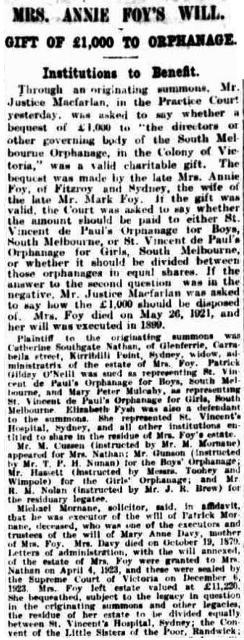
Annie died at Bournemouth a place renowned for its Baths and treatments for people suffering from Consumption at that time. A will, sealed and lodged in 1899 offers some insight;
Foy, Annie, formerly wife of Mark Foy, of Crescent-road, Bournemouth, died 26th May, 1921. Next of kin wanted. £13,368 NEXT OF KIN. (1922, July 4). The Brisbane Courier (Qld. : 1864 - 1933), p. 4. Retrieved from http://nla.gov.au/nla.news-article20556969
Some of what Mark Foy may have been experiencing during these events can be glimpsed in him retiring from full time work at Mark Foy's in 1898 to 'pursue other interests', as reported in one article.
Mark returned per the 'India' in March 1900. Miss E Tweedie, 36, landed in Sydney from aboard the 'Marloo I' in August 1900.
In early September 1900 Mark caught the 'Pateena VI' to Launceston.
On September 19th, 1900 at St Mary's Cathedral, Hobart, Tasmania, he married Elizabeth Dominica Tweedie.
A Mrs M Foy and Infant, aged 1, returned to Sydney per the 'Ophir' - landing in late October 1900.
His zeal for new projects shows in acquiring land in the Blue Mountains in 1901-1902 what would become the Hydro Majestic Medlow Baths, which opened in July 1904.
Mark Foy built the Hydro Majestic Hotel in 1903 and bought land in the Megalong Valley to provide goods and supplies for the hotel. The land he called The Valley Farm. He purchased 300 acres in 1904 then added another 200 acres from Donald Boyd, plus a lease on 640 acres.
He built a large rural holding with a storehouse, stables and buggy shed, 18 stall milking shed, a dairy shed, machinery shed as well as a piggery. He also built a racecourse with a mile long track. The farm grew good crops of corn, turnips, oats.
The Hydro Majestic hotel began as the Belgravia Hotel which was completed in 1891. The hotel is a combination of three grand properties. The first being a property developed by Edward Hargraves who received a grant from the government following his discovery of gold to the west of the Blue Mountains in 1851.
The second was Belgravia Hotel which was built in 1891 next door to the ‘Hargraves House’ and the third was ‘Tuckers House’. The hotel was a health retreat and the building was constructed in Queen Anne style.
Mark Foy (junior, with curly hair) on original Medlow Railway Station B & W Print - 1901 - courtesy Blue Mountains City Library
Belgravia Hotel which was part of the Hydro Majestic Hotel complex, at Medlow Bath, New South Wales. Photographer unknown Date c. 1910. National Library of Australia PIC/6015/31 LOC Box PIC/6015
Mark Foy purchased the site for the Hydro Majestic in 1902 for the purposes of a hydropathic sanatorium under the belief that the land contained mineral springs. At that stage the town was known as 'Medlow' and Mr. Foy successfully petitioned the New South Wales government to change the name to Medlow Bath, the current name. It is not known if he requested the name changed to make the name sound more prestigious, or if he wanted to avoid confusion with another town called Medlow, also in New South Wales.
By the time the hotel opened in 1904, the mineral springs (if they ever existed) had dried up. Mark Foy had mineral water imported from Germany in large steel containers. After travelling in these containers from Germany to Australia the water reportedly tasted awful, and so it was assumed that it must have been good for a person's health. Guests of the hotel were instructed to drink this water on a regular basis.
Guests included King Edward VII, who celebrated his birthday there in 1909, Nellie Melba, who donated a grand piano to the hotel, Australia's first Prime Minister Sir Edmund Barton, who died in the hotel in 1920, Sherlock Holmes' creator Sir Arthur Conan Doyle, Julius Blau of 4711 perfume fame, and the Rajah of Pudukkutai with his Australian-born wife, the former Molly Fink. The cream of Sydney's 'society' were frequent visitors, social columns in all newspapers reporting their 'return to excellent health' after a stay.
Fire destroyed the Gallery building in 1905, and the original Belgravia wing in 1922:
KATOOMBA BLAZE. Famous Hotel Destroyed. £30,000 DAMAGE. KATOOMBA, Friday. - The Hydro-Majestic Hotel at Medlow Bath, a famous tourist resort in the Blue Moun-tains, has been partially destroyed by fire. The fire broke out from an un-known cause in the early hours this morning. The manager, his wife and family, who were awakened by the caretaker, had a narrow escape from the burning building in their night attire. The whole of the central section, known as Belgravia, with its renowned picture gallery, and two storeys of bedrooms, is a smouldering mass of ruins. The picture gallery was one of the features of the Hydro. It contained specimens by many well known artists, also many fine marble busts. It contained specimens of such well-known artists as Lister, Julian Ashton, Tebbutt, Gladstone, Ayre, and Cayley.
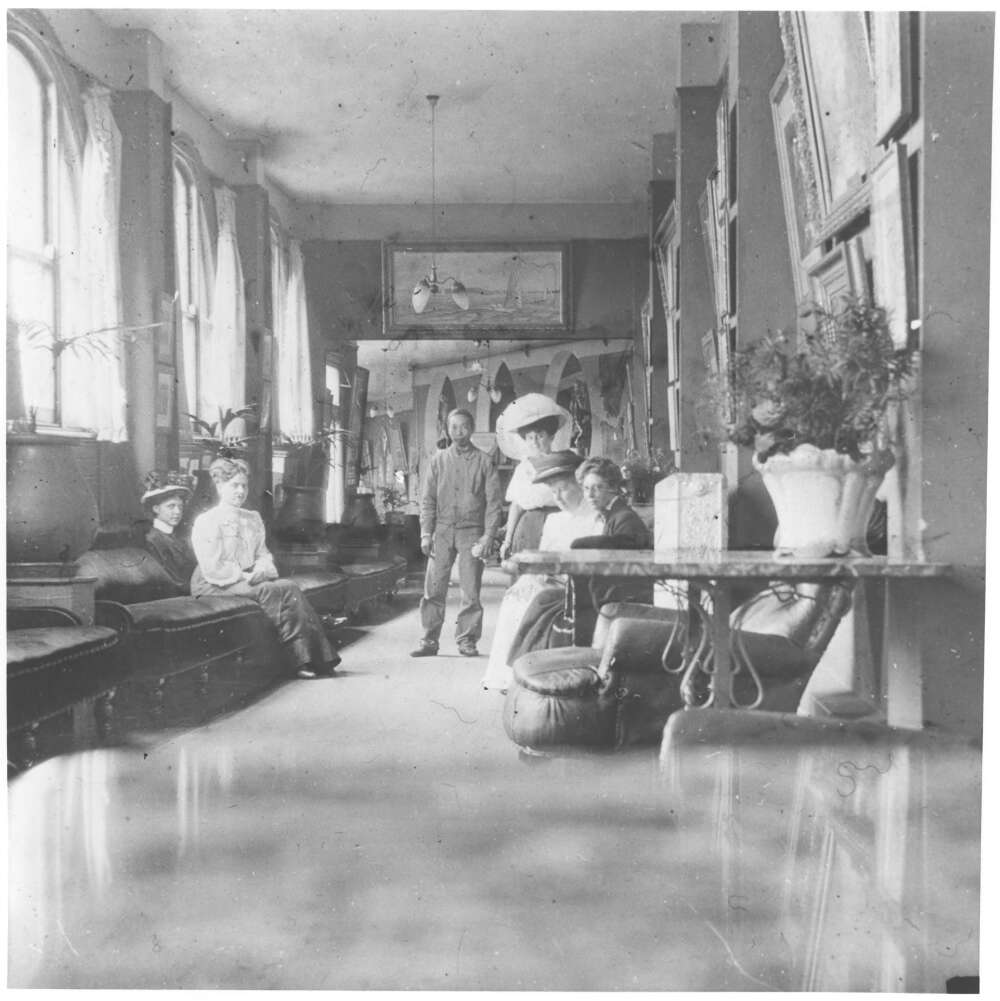
Guests in a gallery of the Hydro Majestic Hotel at Medlow Bath, New South Wales, courtesy National Library of Australia, image no.: nla.obj-146214419-1
[ca. 1910]
Cloister, Medlow Bath Hydro, courtesy National Library of Australia, image no.: nla.obj-146216014-1. [ca. 1910]
Library and writing room at the Hydro Majestic Hotel, Medlow Bath, New South Wales, circa 1910, courtesy National Library of Australia. Image No.: nla.obj-146214911-1
Billiard room at the Hydro Majestic Hotel, Medlow Bath, New South Wales, circa 1910. courtesy National Library of Australia, Image No.: nla.obj-146215215-1
Gallery next to the billiard room of the Hydro Majestic Hotel, Medlow Bath, New South Wales, circa 1910 - courtesy National Library of Australia. Image No.: nla.obj-146216316-1
Woman and car at the main entrance to the Hydro Majestic Hotel, at Medlow Bath, New South Wales circa 1910 - courtesy National Library of Australia. Image No.: nla.obj-146217360-1
Theatre Room inside the Hydro Majestic
Snowy exterior of the casino at the Hydro Majestic Hotel, Medlow Bath, New South Wales, circa 1910. courtesy National Library of Australia, Image No.: nla.obj-146215019-1
Exterior of the Hydro Majestic Hotel at Medlow Bath, New South Wales, 2, circa 1910. courtesy National Library of Australia, Image No.: nla.obj-146214817-1
The Hydro was erected about 20 years ago. It was intended to mark a new departure in hotel accommodation. Altogether it has cost about £90,000. The damage, as a result of the fire, is roughly estimated at £30,000. The building was owned by Mr. Mark Foy. It was leased to the Joynton Smith Trust. The whole of the buildings and contents were insured. KATOOMBA BLAZE. (1922, August 19). Advocate (Burnie, Tas. : 1890 - 1954), p. 5. Retrieved from http://nla.gov.au/nla.news-article66728078 and A BIG FIRE. (1922, August 26). Chronicle (Adelaide, SA : 1895 - 1954), p. 42. Retrieved from http://nla.gov.au/nla.news-article87435205
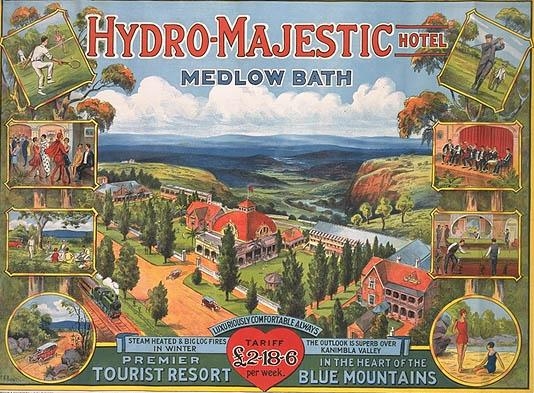
Few tourists, visit the Blue Mountains without looking over the great, somewhat straggling building which picturesquely hangs over the Kanimbla Valley. Well-known as the Hydro-Majestic was as a mountain resort,it was even better known because of its history, its unusual architecture, and its unique, in places luxurious, appointments and fittings. The building had a frontage of about 1000 feet to the main Western-road.
The picture gallery was the show portion of the building, where, in addition to canvases by some well-known painters, there were a number of good pieces of statuary. The residential portion of the building had been closed for some weeks, the only visitors being tourists, who stopped for an hour or so to look through the building. Mr. Millett, the manager of the hotel, lived in the building with his wife and family and four children. The first person to notice the fire was one of the employees of the place, Mr. Harry Skeen, who lived in a cottage nearby. He was sleeping out on the verandah of his cottage, and was awakened at about 3 a.m. by an unusual glare. He found the western wing of the building ablaze, and rushed across to awaken the manager. Mr. Millett and his family were all asleep, although heavy smoke was pouring into that portion of the hotel. They all got out safely. The flames, fanned by a stiff westerly wind, spread rapidly, and formed a fiery pillar that was visible for many miles about. The Katoomba Fire Brigade was notified, but it was not until 4.30 a.m. that it came into action. The few firemen had a difficult task, rendered harder by a poor water supply,which was later augmented by running a lineof hose to a hydrant nearly a quarter of a mile away. It was not until a couple of hours later that the flames were beaten back and there was no danger of the fire spreading to the eastern portion of the hotel,which contains, in addition to many bed-rooms, a casino and large billiard-rooms. The Hydro-Majestic was built some 20 years ago by Mr. Mark Foy, who intended it as a luxurious tourist hotel. Later it was leased to Sir Joynton Smith, the present lessee. HYDRO-MAJESTIC. FIRE AT MEDLOW. (1922, August 19). The Sydney Morning Herald (NSW : 1842 - 1954), p. 13. Retrieved from http://nla.gov.au/nla.news-article16019743
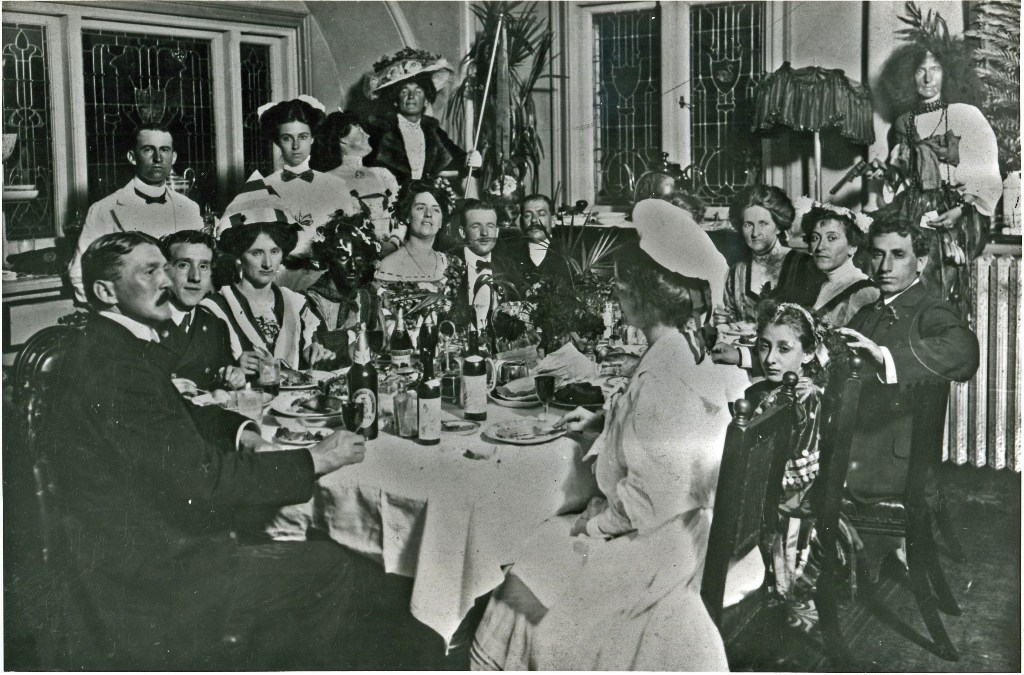
Hydro Majestic staff ball c1910. Notes: Mark Foy, owner of the hotel, standing centre back, wearing his wife's hat and dress with wig. Unknown gent on right in frock and wig with six shooter. Courtesy Blue Mountains City Library
Sun Bath Road, Hydro Majestic - On the right is Mrs Mark Foy (Elizabeth). File: 000\000834, courtesy the Blue Mountains Library
Elizabeth gave birth to their child Maxine in 1902, the same year this huge 'healing' edifice was commenced. In 1903 Alice S R (called Sheleagh) was born and his second son, Francis Jefferson, in 1908.
Mark Foy, pictured here with his family - circa 1915
Mark Foy's clearly quick mind and passion for all new innovations of humankind, combined with a buy and sell upbringing of knowing how to keep the financial wheels turning to back all ventures, runs through his passion for motor cars. According to information gleaned from Foy’s niece Mary Shaw by motoring historian Bill Boldiston, at the turn of the 19th century Mark Foy asked his friend Bill Elliott, who lived in France, to purchase a motor car for him.
Elliott dutifully did so, buying an 1899 3hp De Dion Voiturette Vis a Vis motor car in London for 175 pounds and 10 shillings and a further 9.13.10 worth of accessories on January 26, 1900. It arrived in Sydney on April 27 and cleared Sydney customs on May 15 that year. The vehicle seems to have been the first motor car imported into NSW.
Mark Foy (far right) in his Panhard 1901
After opening his “Palace in the wilderness’’ in 1904, Foy and another nearby hotel owner and keen motorist, Tom Rodriquez, began a daily service to Jenolan Caves featuring Foy’s latest import, a 10hp Panhard et Levassor. Mr. Foy then imported two Milnes-Daimlers in chassis form, which became Charabancs, and offered hotel guests motor tours.
He later bought three Bedelia French cyclecars, which he kept at his Megalong Valley property, Valley Farm. The vehicles were made available to guests who wished to indulge in motor racing on the nearby Medlow Showground circuit.
Foy’s next purchase, a 1910 Fiat Tipo Zero, so impressed him that he became an agent for the brand.
Not only did he compete in the first ever marathon car race in Australia from Sydney to Melbourne he also had the knack for using his collection at Medlow Baths as well as selling it off when it suited:
MOTORING. DUNLOP RELIABILITY RACE. TWO CARS WRECKED. GUNDAGAI, Wednesday -The section of the Dunlop Reliability Motor Race today from Goulburn to Gundagai, through beautiful country and on comparatively good roads, was not accomplished with
out stirring incidents. Two Victorian competitors for the Buchanan Trophy met with accidents, and there is no prospect of either car concerned being repaired for the three remaining sections. A third Victorian, Mr. H. J. Stevens, again proved himself to be the speediest motorist on the road. He went for speed, and notched a great performance when the long hill climbing is taken into account. The first batch of motorcycles was despatched at a quarter to 7 o'clock. By 8 o' clock nearly 30 cycles or cars were on the road. Mr. Mark Foy, whose car suffered on Tuesday, was a late starter, with one or two others. MOTORING. (
1905, February 23). The Argus (Melbourne, Vic. : 1848 - 1956), p. 5. Retrieved from
http://nla.gov.au/nla.news-article9885216
A GOOD IDEA. MARK FOY'S MOTORS, FROM MEDLOW BATH. Regarding the UNRESERVED SALE of the 15 MOTORCARS of Mr. MARK FOY, who is leaving for England, a good idea is suggested, and will be carried out, SALE ON THE LAWNS OF "EU-MEMMERING," BELLEVUE HILL, near Tram Terminus, 7th SEPTEMBER-WEDNESDAY. CARS ON VIEW: Sunday, Monday,Tuesday, and Wednesday. INTENDING PURCHASERS can have a trial on the stiff hills in the neighbourhood to show that all is right with the cars. As all the famous Medlow Bath drivers, who are the best in Australia, will be temporarily out of work, and attending the Sale to show the cars off, they will instruct any purchaser of a Car how to drive it, and give them, if it is necessary, ONE WEEK'S LESSON IN THE PARK FOR ONE GUINEA. If you are a buyer you will thusly get the most expert training in driving your purchased Car in a manner as not to injure it until you become your-self thoroughly experienced. Advertising. (
1910, September 1).
The Sydney Morning Herald(NSW : 1842 - 1954), p. 6. Retrieved from
http://nla.gov.au/nla.news-article15183655
MOTOR CARS. On the Lawn of EUMEMMERING HALL, BELLEVUE BILL.Under favoured instructions received from MARK FOY, ESQ., Consequent upon his early departure for Europe,The Whole of his FINE COLLECTION OF MOTOR CARS, of Various Manufacture. Including: TWO 18-31 H.P. FIAT CARS. TWO 10-12 H.P. FIAT CARS. 15-22 NEW CABRIOLET STOEWER CAR. This Car has not run 1500 miles, fitted with C..A.A'.Lighting Set, and is the most perfectly fitted Car in the State. TWO 8-10 H.P. DE DION CARS. 12-10 H.P. LIMOUSINE N.A.G. CAR. 10-12 H.P. STOEWER CAR. Detailed particulars set out in Catalogues, which can be obtained from the Auctioneers, or will be posted on application. BARNARD AND CO. will sell by auction as above.
Written on the rear of the original print is From Miss M. McGahey, Bayview, NSW. (Miss M McGahey was one of his grand-daughters via first daughter Maxine. Ed.) Car belonged to late Mr. Mark Foy while the front reads – in Mark Foy’s hand? – Car I bought from Mass(?). French car about 1901(?) in Sydney. £150. Photo owned by David Manson and sourced from Serpolette's Tricycle, The Early Motor in Australiasia, Newsletter, No 6, December 2012 who state Mark Foy is a "pioneer NSW motorist".
Another aspect of this man's interests that shows up in Pittwater and perhaps points to friendly support of his then neighbours the Pittwater Aquatic Club and their early history of rowing, shows in his sponsorship of the Mark Foy Race in Pittwater Regattas during the 1920's and 1930's.
Apart from being on good terms with the Williams he was also good friends with the Riddles of Bayview, MVHA lady Eileen Gordon, who was great friends with May Riddle, recalls donating a photograph of Mr. Foy and May's father, Andrew to the Manly, Warringah and Pittwater Historical Society. This support of rowers and rowing can be traced back to an older interest in this sport;
THE SCULLING CHAMPIONSHIP-MARK FOY GIVES STANBURY A NEW BOAT
London, July 6. James Stanbury is undergoing a sound preparation for his match with Harding for the sculling championship of the world on Monday next. Mr. Mark Foy, of Sydney, has presented Stanbury with a new boat, to be used in the match. THE SCULLING CHAMPIONSHIP. (
1896, July 10).
The Inquirer & Commercial News (Perth, WA : 1855 - 1901), p. 7. Retrieved from
http://nla.gov.au/nla.news-article66541367
James (Jim) Stanbury (1868-1945), sculler, was born on 25 February 1868 at Mullet Island, Broken Bay, New South Wales, son of James Stanbury, a farm labourer from Devonshire, and his Sydney-born wife Catherine, née Reilly. Several years later the family shifted to Nowra where young James learned to row on the Shoalhaven. In 1887 he moved to Sydney to join the professional sculling ranks and within a year had stunned onlookers by finishing a close second when Henry Searle set a Parramatta River record. Following Stanbury's successful defence of his title against Charles Harding, the English champion, in July 1896 in London, Gaudaur agreed to race over the neutral Thames course. In a contest where Stanbury claimed a foul, Gaudaur took the world title on 7 September. The Australian was received coolly in Sydney for having refused to row out the match at racing speed.
"AQUATIC WEEK"
Mr. Foy's Idea
BROKEN BAY CHOSEN
Mr. Mark Foy, commodore of the Sydney Flying Squadron, takes a particularly keen Interest in the aquatics of the Pittwater district, and is financially assisting the local aquatic club in staging a two days' regatta on Boxing Day and New Year's Day. Mr. Foy is of the opinion that New South Wales should develop an 'aquatic week." and considers that the placid waters of Broken Bay, in the vicinity of Bayview an Ideal spot for the launching next season of a weeks camping regatta, embracing the Christmas and New Year holidays. He considers races could be arranged every day, and that all the clubs on Port Jackson would be glad to cooperate.
Mr. Mark Foy.
Professional Sculling: The Mark Foy Mens Single Sculls (heavy boats) "Final H Robson 1 J Wilson 2 C Mudie 3 won by three lengths ". PITTWATER REGATTA. (
1934, December 31).
The Sydney Morning Herald (NSW : 1842 - 1954), p. 13. Retrieved from
http://nla.gov.au/nla.news-article17117750
Shortly after the next world war began Mr Foy lost his second wife;
DEATH OF MRS. MARK FOY.
Mrs. Elizabeth Foy, daughter-in-law of the founder of Mark Foy's Ltd has died in California after an operation for appendicitis. She left Australia on a world tour in April 1939 with her husband, Mr. Mark Foy, chairman of directors of Hydro Majestic Ltd Medlow Bath, and their daughter Miss Sheleagh Foy. Their elder son, Mr. Mark Francis Foy, and his wife left Sydney in December to join his parents in the United States and all had taken their passages to return this week by the same steamer. Two other members of the family, Mrs. Maxine McGahey and Mr. Jefferson Foy are in Sydney. The body will be be brought to Sydney for the funeral. DEATH OF MRS. MARK FOY. (1940, July 11). The Sydney Morning Herald (NSW : 1842 - 1954), p. 9. Retrieved from http://nla.gov.au/nla.news-article17683793
Elizabeth's funeral took place almost six weeks later;
FUNERAL OF MRS. ELIZABETH FOY.
The remains of Mrs. Elizabeth FOY, daughter-in-law of the founder of Mark Foy's, Ltd., who died in Southern California on July 9 after an operation for appendicitis, have been brought to Sydney for burial. There will be a Requiem Mass at St Mary's Cathedral at 10 o'clock this morning, after which the cortege will move to the South Head Cemetery. FUNERAL OF MRS. ELIZABETH FOY. (1940, August 21). The Sydney Morning Herald (NSW : 1842 - 1954), p. 13. Retrieved from http://nla.gov.au/nla.news-article17677065
Plans to change things at Bayview appear in Warringah Shire Council records;
Ordinary Meeting. Subn. A 1/4/41. 39. G. S. Hackeller & Son, Solicitors, 23/3/41, submitting, on behalf of Mr. Mark Foy, plan of proposed subdivision of part of Portion 28, Bayview Road, Bayview. Resolved, - That the plan be approved provided that the strip marked "Access" are to be part and parcel of the rear block. (Crs. Campbell, O'Reilly)
The above was part of a larger land holding at Bayview;
Primary Application - Mark Foy 12 Acres 28 1/4 perches on Bay View Road in Parish Narrabeen County Cumberland Volume 6442 Folio 107 - Date Range: 1949-07-20 to 1952-02-05 - NSW State Records Series 17513 / Primary Application Packets
This gentleman of innovation continued in his love of sailing, attending to family business and watching his precious Hydro Majestic come in for War Service as this construction against the toll of disease and unhappiness was used for convalescing American servicemen during WWII to once again be a haven of restorative health and a few laughs.
One source researched states; "Instead of getting out of bed to turn a light switch off, they'd shoot the bulb out with a revolver," said Mrs Mary Shaw, grand-daughter of the hotel's founder, Mark Foy. "They had mouse traps hidden on couches and chairs to catch the unwary and they rolled some statuary down the cliffs at the back... They disposed of a herd of wild goats that my grandfather had imported... the whole lot of them for target practice just for something to do." GERALDINE O'BRIEN, Heritage Writer, Glory days are coming back to the Hydro Majestic. 2009.
After a lifetime filled to the brim with doing, giving, and introducing new innovations to his fellow Australians, Mr Foy, by now aged, responded with characteristic determination to one last challenge.
The following are obituaries for Mark Foy:
FALL CAUSES DEATH OF LEADING BUSINESSMAN.
Mr. Mark Foy, who with two other brothers started the firm of Mark Foy's Limited more than 70 years ago, died in St. Vincent's Hospital last night, aged 85. Mr. Foy, who lived at Victoria Road, Bellevue Hill, died following a fall in his garden at his Bayview cottage. He was admitted to hospital at noon yesterday and died about midnight. Mr. Foy was in bed about 4 o'clock yesterday morning, when he thought he heard a burglar in the grounds. He got out of bed and was walking through a garden patch when he slipped. Mr. Foy was one of Sydney's leading business figures. He was known for his generosity and donated large amount to charity. He was also "prominent" in the sporting world. His main activity was sailing and he was the originator of 18ft sailing in Australia. He owned many championship boats and sailed them in England and Europe. In his youth Mr. Foy was also a good rifle shot. In America when 16 he won several medals for shooting.
Mr. Foy was born in Bendigo. His father, an Irishman started the Melbourne firm of ‘Foy and Gibson.’ The Foy family decided to branch out into Sydney, and Mr. Mark Foy and two other brothers came here and established the business. He was the only surviving brother.
Mr. Foy built the Hydro Majestic at Medlow Bath. Sydney Flying Squadron's fleet will fly black mourning ribbons from masts in Saturday's race in the Harbour. This will be the Squadron's tribute to its founder and its patron, Mr. Foy. Mr. Foy founded the Squadron in 1892 and retained the keenest interest in it until his death. SFS secretary (Mr. W.J. Anderson) said today that all skippers should see black ribbons were flown on Saturday. "Mr. Foy's death has cast gloom over the Sport, his sportsmanship and generosity will long be remembered" added Mr. Anderson. Mr. Foy is survived by two sons and two daughters. Mr. Mark F. Foy, Mr. F. J. Foy, Mrs. McGahey and Miss Sheila Foy. No arrangements have yet been made for the funeral. DEATH OF MR. MARK FOY. (1950, November 17). The Sydney Morning Herald (NSW : 1842 - 1954), p. 13. Retrieved from http://nla.gov.au/nla.news-article18186921
DEATH OF MR. MARK FOY
Fall In Garden
Mr. Mark Foy, well-known in business early in the century, died in St. Vincent's Hospital on Wednesday night following a fall early on Tuesday morning. He was 85.
Mr. Foy thought he heard a noise in the garden of his Bay-view home about 4 a.m. on Tues-day and is believed to have fallen while searching the garden.
Requiem Mass will be held at 9 a.m. to-day at the Holy Cross Church, Bondi Junction, and the funeral will leave the church at 9.30 a.m. for South Head Cemetery.
Mr. Foy, who was born in Bendigo (Vic.), became a member of the Melbourne firm of Foy and Gibson, which had been founded by his father. With his three brothers he came to Sydney in 1884 and started the firm of Mark Foy's.
RETIRED IN 1908
In 1908 it was floated as a public company and Mr. Foy retired from active participation in the business.
He later built the Hydro Majes-tic Hotel at Medlow Bath and maintained a keen interest in that concern until about 1936.
Since the turn of the century Mr. Foy had travelled extensively in Europe and the Far East.
He was a leading sportsman and in 1892 founded the Sydney Flying Squadron. As a young man in the United States Mr. Foy won several medals for rifle shooting.
Mr. Foy is survived by two sons, Mr. Mark Foy, Jnr., and Mr. Francis Jefferson Foy, and two daughters, Mrs. Maxine McGahey and Miss Sheila Foy.
Sydney Flying Squadron boats will fly black mourning ribbons when their boats race on Sydney Harbour to-morrow.
DEATH OF MR. MARK FOY (1950, November 17). The Sydney Morning Herald (NSW : 1842 - 1954), p. 13. Retrieved from http://nla.gov.au/nla.news-article18186921
Fortunately in 2008 a discovery allows us to ensure the legacy of all this gentleman brought and gave to so many lives on:
International 18ft Skiff Class Association - Double Bay, Sydney, Australia, Press Release, December 13, 2008
-New Trophy for the International 18ft Skiff Circuit
- The 18 Foot Skiff International Association is delighted to announce a new global competition, the Mark Foy Trophy, to be sailed for the first time in Carnac (France) between June 29th and July 04th 2009. Mark Foy was one of the founders of the 18ft Skiff Class in Sydney in 1892 and a uniquely designed trophy bearing his name was recently rediscovered in the clubhouse of the Sydney Flying Squadron. Newly renovated and kindly donated by the Foy family, this valuable trophy will now take its rightful place as an International 18ft Skiff trophy. As a sign of the importance of the class outside Australia, and to show particular support for the class in Europe, the first venue to hold a series of races for this Trophy will be Carnac in France, often cited as the birthplace of European 18ft Skiff racing. A huge turnout of 18ft Skiffs is expected, with over 30 boats representing Australia, New Zealand, the USA and many European countries, with previous JJ Giltinan winners and champions from other classes competing over 6 days in a gala event hosted by Yacht Club de Carnac. John Harris, Commodore of the Australian 18 Footer League, comments, "Our International class organisation is mandated to foster the growth of the class building on its success Internationally, and promoting the regattas held annually in Australia, Europe and the USA. The JJ Giltinan Trophy has been raced as a "world championship" on Sydney Harbour since 1935, and the Mark Foy Trophy is both a reflection of the popularity of 18 Footer Sailing Internationally and a fitting celebration for the class as it looks to continue its growth on all continents. The JJ Giltinan event will continue to be run in Sydney every year and maintain its iconic status as one of the ultimate sailing trophies to be won in the world today".
In 2010, the Mark Foy Trophy will return to its birthplace in Sydney, Australia and will be run alongside the JJ Giltinan Trophy to celebrate the 75th Anniversary of the world's most exciting skiff class. San Francisco in 2011 and Auckland in 2012 are then scheduled hosts for the Mark Foy Trophy.
Notes on the trophy:
The trophy was designed by Mark Foy and crafted in Hong Kong in 1935. It stands 50cm tall, and is decorated with an ornate Chinese junk on top, reflecting the origin of the trophy and Mark Foy's passion for travel. On the handles, and embossed on the base, are shapes of the Australian "Dugong", a native Australian fish that by law can now only be fished by indigenous Australians. This unique and valuable trophy will take up permanent residence in the Sydney Flying Squadron opposite the Harbour Bridge, overlooking the waters where 18ft skiff racing started. From:
http://www.sailingtexas.com/markfoytrophy
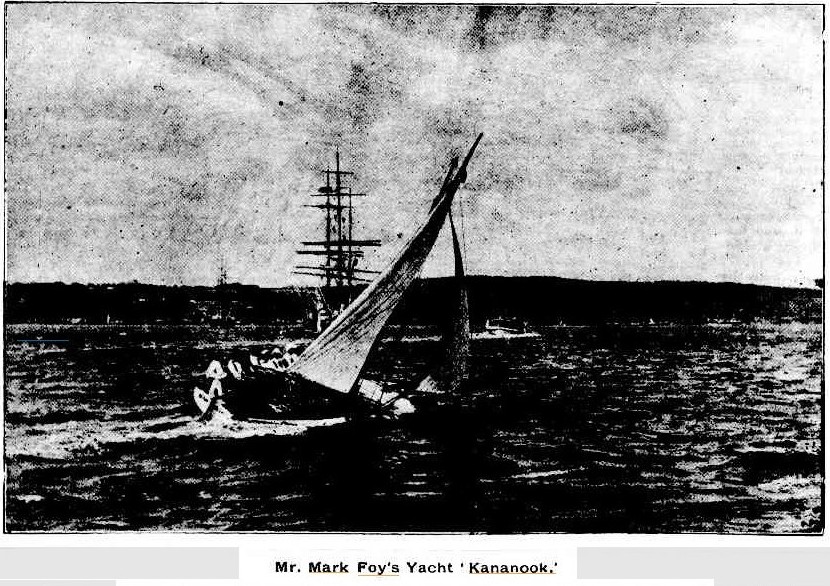

 In the life of Mark Foy is seen some of our pioneer Australian spirit, our impetus to get up and go, to create new frontiers where old class systems tried to place obstacles by establishing sailing for all, especially the working man, and being the founder of the Sydney Flying Squadron in 1890 (some sources state it was 1891, others cite 1892) as well as introducing handicap racing, which was originally referred to as the 'Mark Foy System';
In the life of Mark Foy is seen some of our pioneer Australian spirit, our impetus to get up and go, to create new frontiers where old class systems tried to place obstacles by establishing sailing for all, especially the working man, and being the founder of the Sydney Flying Squadron in 1890 (some sources state it was 1891, others cite 1892) as well as introducing handicap racing, which was originally referred to as the 'Mark Foy System'; 

 Mark Foy continued to travel every year. World events which affected the high seas on one occasion meeting his path mid-voyage on the aforementioned trip:;
Mark Foy continued to travel every year. World events which affected the high seas on one occasion meeting his path mid-voyage on the aforementioned trip:;


 The note that resonates strongest from masses of material is a love of sailing and his favourite vessel, the Flying Fish, an earlier catamaran which he tried to find or rebuild once she disappeared.
The note that resonates strongest from masses of material is a love of sailing and his favourite vessel, the Flying Fish, an earlier catamaran which he tried to find or rebuild once she disappeared. 








